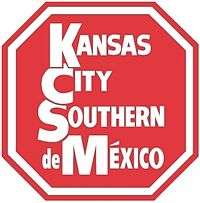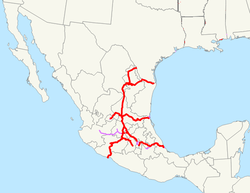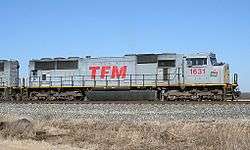Kansas City Southern de México
 | |
 Kansas City Southern system map | |
| Reporting mark | TFM |
|---|---|
| Locale | Mexico |
| Dates of operation | 1997–present |
| Track gauge | 4 ft 8 1⁄2 in (1,435 mm) standard gauge |
| Headquarters | Monterrey |
| Website | http://www.kcsouthern.com/ |
Kansas City Southern de México (KCSM), formerly Transportación Ferroviaria Mexicana (TFM), is the name of a company dedicated to freight transportation using rail in the northeastern part of Mexico. KCSM is fully owned and operated by Kansas City Southern, who owns its own fleet and the rights to operate and maintain a rail system through a concession from the Mexican government. The majority of the rail system spans from the Mexico City Valley to the United States border at Laredo, Texas; there are also tracks that connect to the port cities of Lázaro Cárdenas and Veracruz, giving Kansas City Southern de México a unique position because they connect both the Gulf of Mexico and the Pacific Ocean to the United States border.[1]
History
Kansas City Southern de México was originally formed in 1996 when Kansas City Southern Industries and Transportación Maritima Mexicana (TMM) purchased a government concession to operate on a rail system in Mexico. It was the Mexican President, Ernesto Zedillo who proposed the privatisation of the Mexican railways because the Mexican railway system had fallen into a state of disrepair and needed drastic work to become profitable. Since the late 1930s, Mexican trains and tracks were property of the government as Ferrocarriles Nacionales de México (Mexican National Railways). The nationalized railroad operated successfully for many years, yet, by the 1990s, the system was so poorly run, that US railways would not even send rail cars into Mexico, for fear that they would not be returned. When the decision to privatize the railroad was made, only 15% of freight was moved by rail in Mexico (versus 42% in the US[2]).
The most sought-after portion of the concessions, called the Northeast Railroad, was bid on by many major companies, including the United States's largest railroad company, Union Pacific Railroad. This concession included about 3,638 km (2,261 mi) of track with connections to many key cities, including Monterrey, Mexico City, and Laredo. This track carried 46% of all rail traffic in Mexico and 60% of all freight coming from the United States.[3] KCSM and TMM bid and won the concession for $1.4 Billion USD for the rights to operate the concession, each paying 49% and 51%, respectively.
In 2005, Kansas City Southern Industries purchased Transportacion Maritima Mexicana's share in TFM, giving them full ownership of the company, and the TFM was officially renamed Kansas City Southern de Mexico, S.A. de C.V.[4] Today, KCSM includes 2,261 miles (3,638.7 km) of track, serving northeastern and central Mexico and the port cities of Lazaro Cardenas, Tampico, and Veracruz among others.
11 of 14 of Mexico's auto assembly plants, plus two more under construction, are located on the railroad.[5] Automobile traffic (autos and parts) accounted for 9% of the 2012 total carloads.[6]
Key Connections


- Laredo
- Lázaro Cárdenas
- Guadalajara
- México City
- Monterrey
- Queretaro
- Saltillo
- San Luis Potosí
- Tampico
- Veracruz
See also
References
- ↑ Kansas City Southern Company Profiles, Kansas City Southern Industries.
- ↑ Overview of U.S. Freight Railroads, from the National Atlas.gov.
- ↑ Overview of U.S. Freight Railroads, The Mexican Railroad Industry
- ↑ Heaster, Randolph (December 6, 2005). "Kansas City Southern railroad has new name". Kansas City Star. Retrieved 2005-12-06.
- ↑ Trains Magazine, November 2013 (Vol 73-Issue 11) ISSN 0041-0934 "Map of the Month: Auto Plants of North America" by Bill Metzger, Pages 44 & 45
- ↑ Trains Magazine, November 2013 (Vol 73-Issue 11) ISSN 0041-0934 "Kansas City Southern Bets Big on Mexico" by Roy Blanchard, Page 70
External links
| Wikimedia Commons has media related to Kansas City Southern de México. |
- KCSM official website
- Kansas City Southern official website
- MEXLIST—The Group for Mexican Railway Information